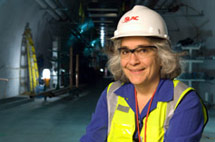

Thursday - December 17, 2009
SLAC Today is
available online at:
http://today.slac.stanford.edu
In this issue:
SLAC/Stanford's Zhi-Xun Shen Receives 2009 E.O. Lawrence Award
From the Director: FY09 DOE Report Card
KIPAC Workshop Looks Back in Time to Understand the Universe
Special Seminar Today: Recent Results from CDMS
Symmetry Explores Data Preservation, the Fermi Telescope, and More
December Fire Safety Tips
Physics Geek Gift of the Week: Young Mad Scientist's Alphabet Blocks
 |
 |
|
Thursday - December 17, 2009 |
SLAC/Stanford's Zhi-Xun Shen Receives 2009 E.O. Lawrence AwardZhi-Xun Shen, director of the Stanford Institute for Materials and Energy Science, or SIMES, a joint institute of the Department of Energy's SLAC National Accelerator Laboratory and Stanford University, has been awarded the Ernest Orlando Lawrence Award by the U.S. Department of Energy. Shen, who received the prize for his pioneering work in materials science, is among six other distinguished awardees, announced on December 16, 2009. "The contributions made by these researchers to advance the national, economic and energy security of the United States are wide-ranging and meaningful," Secretary Chu said. "I congratulate the winners and look forward to their discoveries still to come." One of the highest scientific honors that is bestowed by the U.S. government, recipients of the E.O. Lawrence award receive citations signed by the Secretary, a gold medal bearing the likeness of the award's namesake, Ernest Orlando Lawrence, and a $50,000 honorarium. Read more... From the Director: FY09 DOE Report Card
(Photo by Linda Cicero.) This week the Department of Energy Office of Science released annual performance assessments for the national labs, including SLAC National Accelerator Laboratory, for the fiscal year 2009 (October 2008 through September 2009). The assessment is based on the goals set in the lab's FY09 DOE Performance Evaluation and Management Plan, or PEMP. The hard work of everyone at the lab over in recent years, together with our lab-wide efforts to be our own harshest critics, have paid off. In this year's PEMP scores, SLAC once again earned an overall science and technology grade of A-. The management and operations score of B+ represents sustained performance and continued improvements from our mission support staff. Read more... KIPAC Workshop Looks Back in Time to Understand the UniverseIn the past few years, data from advanced telescopes and satellites—such as the Fermi Gamma-ray Space Telescope
all-sky map above—have revealed the extragalactic background light at a wide range of wavelengths. (Image courtesy of NASA/DOE/International LAT Team.)
When astronomers look to the sky, they see millions upon millions of individual objects: the discernable stars and other sources of light that make up our universe. But they also see a faint, diffuse glow spread across the entire sky that can't be attributed to single sources. This light, which consists mostly of the light from galaxies and quasars too far away to individually resolve, was the subject of the Cosmological Implications of the Extragalactic Background Light workshop that took place at SLAC on Tuesday. "After you subtract all of the point sources from your view of the sky, the extragalactic background light is what's left," said Kavli Institute for Particle Astrophysics and Cosmology postdoc Lukasz Stawarz, who co-organized the workshop with colleagues Neelima Sehgal and Jack Singal. In addition to the blurred light of distant astronomical objects, the EBL also includes the cosmic microwave background, a faintly glowing relic of the hot, dense, young universe. Together, these sources contain information regarding the history and formation of galaxies, and the large-scale structure of the universe. Read more... Special Seminar Today:
|
Events (see all | submit)
Access (see all)
Announcements
|
|
| | ||
|
|
||
 <%
Response.AddHeader "Last-modified", getArticleDate()
'Response.AddHeader "Last-modified","Mon, 01 Sep 1997 01:03:33 GMT"
'Monday, December 06, 2010
%>
<%
Response.AddHeader "Last-modified", getArticleDate()
'Response.AddHeader "Last-modified","Mon, 01 Sep 1997 01:03:33 GMT"
'Monday, December 06, 2010
%>View online at http://today.slac.stanford.edu/. |
||